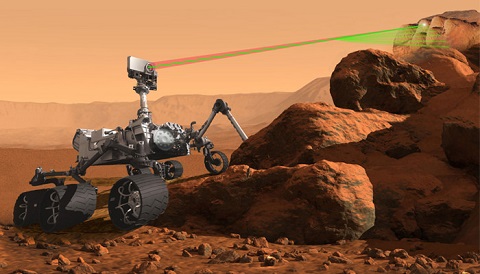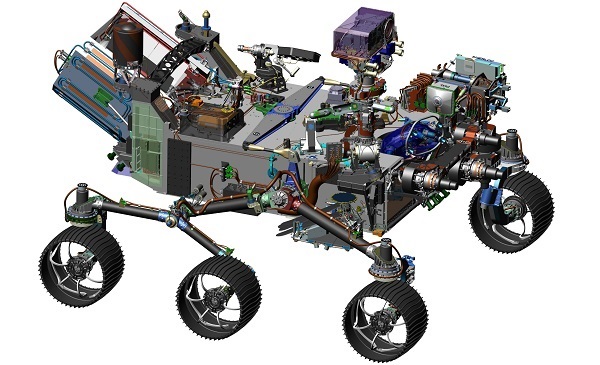Mars 2020 Rover Construction Moves Ahead
The Mars 2020 rover reaches a third milestone on the path to the launch pad.

An artist's concept of the Mars 2020 rover in action.
NASA
NASA
Things are getting real now. Last week, NASA announced that it will proceed with the final design and construction of the Mars 2020 rover. The announcement comes after intensive engineering and design studies that evaluated proposals for instrument packages.
Set to launch in the summer of 2020, the as-yet unnamed Mars 2020 rover will arrive at the Red Planet for its very own "seven minutes of terror" by February 2021. And it has now reached the third of four Key Decision Points on the long road to the launch pad. Phase A was the concept and requirements definition and Phase B was preliminary design and technology development. Now NASA has approved entry to Phase C, the final design and fabrication of the actual rover. (The final Phase D will include assembly, integration, and testing leading up to launch.)
“The Mars 2020 rover is the first step in a potential multi-mission campaign to return carefully selected and sealed samples of Martian rocks and soil to Earth,” says Geoffrey Yoder (NASA Science Mission Directorate) in a recent press release.
Mars 2020 Instruments
We're also now getting a good look at just what instrument packages will make the cut.
Unlike Curiosity, Mars 2020 will explicitly look for signs of life, past and present. The primary goal of the mission is motivated by exploring regions where life could have existed. To this end, the Mars 2020 rover will carry a suite of instruments from institutions in the U.S., France, Spain, and Norway. This vehicle weighs in at about 1,050 kilograms, the heaviest payload fielded on any planetary surface yet. (It beats Curiosity by 150 kg).
Like Curiosity, the Mars 2020 rover is equipped with a powerful laser and drill, complete with replacement bits. This isn't your parent's Mars rover, however.

A look at the new design for the Mars 2020 rover.
NASA / JPL-Caltech
NASA / JPL-Caltech
Here's a rundown of what's onboard Mars 2020:
PIXL: The Planetary Instrument for X-ray Lithochemistry: This X-ray fluorescence spectrometer will enable high resolution analysis of soil samples. The Mars 2020 mission will also package and cache the soil samples it collects for a later potential sample return mission.
RIMFAX: The Radar Imager for Mars' subsurFAce eXperiment generates powerful ground-penetrating radar that will probe below the rover to a depth of several dozen meters.
MEDA: The Mars Environmental Dynamic Analyzer, this instrument package will provide extensive meteorological measurements, including wind direction, speed, temperature, pressure, humidity, and dust particle shape and size during dust storms.
MOXIE: The Mars Oxygen ISRU Experiment (yes, an acronym containing acronyms!) will test the ability for future astronauts to "live off the land," producing oxygen from carbon dioxide drawn from the tenuous Martian atmosphere.
SHERLOC: The Scanning for Habitable Environments with Raman and Luminescence for Organics and Chemicals. This is the potential "life-finder," which will utilize fine scale UV-imaging in the search for organic compounds.
SuperCam: This instrument will image and analyze the chemical composition of the surrounding terrain, as well as detect the presence of organic compounds in rocks and regolith from a distance.
A new and improved stereoscopic imaging system known as Mastcam-Z will also scan the terrain around the rover in high-definition detail. Though previous rovers weren't meant to scan the skies, they've proven to be serendipitous Martian astronomers as well, nabbing images of the fleeting Martian moons.

Phobos transits the Sun as seen by Curiosity.
NASA / JPL-Caltech / Malin Space Science Systems / Texas A&M Univ.
NASA / JPL-Caltech / Malin Space Science Systems / Texas A&M Univ.
The sky crane Entry Descent and Landing (EDL) phase for Mars 2020 also borrows from Curiosity's historic landing procedure. An onboard range trigger will allow for a parachute from the rover to open on command after terrain analysis. Curiosity opened its chute only when it hit a certain descent speed. Mars 2020 will do the same, but it will have an estimated 50% smaller landing ellipse. It'll also have the option of diverting its landing site if it spots hazards. We should see some amazing video shot not only from the sky crane as the rover descends, but from the rover looking back up at the chutes as they deploy.
Mars 2020 will, like Curiosity, sport a plutonium-238 powered Multi-Mission Radioisotope Thermoelectric Generator. This will give it an estimated 10-year operational life span (Pu-238 has a 87.7 year half-life). NASA is experiencing a plutonium shortfall, and the Department of Energy only in 2013 announced that it would restart the plutonium production pipeline for U.S. space exploration. Curiosity actually used plutonium purchased and re-purposed from the Russians. (Note: the Pu-239 isotope is the fissile weaponized version and, unfortunately, can't be reused in RTGs).
NASA has yet to announce a formal name for the Mars 2020 rover, but a naming campaign similar to the one that christened Curiosity will get underway later this year. Landing site selection is also currently in progress, with sites narrowed down to eight regions. A final decision should be announced in July 2019. There's always a bit of tension in this process, as engineers prefer to land in safe areas, while scientists would love to go explore interesting (and more rugged) terrain.
Mars Microphones & Helicopter Drones
A set of microphones will also fly to Mars in 2020. What does a Martian dust storm sound like? What noises does a rover make, as it creaks along? The Mars 2020 mission will let us hear for the very first time the sounds that accompany the sights from the surface of a brave new alien planet.
The road to put a microphone on another world has been a long one. The Mars Polar Lander featured a microphone, but the rover crashed on descent on December 3, 1999. Its predecessor, the Phoenix Lander, delivered a microphone intact to the Martian surface, installed on the MARDI descent imager package, but engineers switched it off due to concerns that MARDI would interfere with other crucial electrical systems. The acoustic sensor aboard ESA's Cassini-Huygens mission did return some very brief audio during its descent through the atmosphere of Saturn's large moon, Titan. The addition of microphones to Mars 2020 rover gives us a new chance at hearing an alien world.
Meanwhile, though NASA has been funding the development of helicopter drones, there's no official word yet if one would head to Mars in 2020. Such a drone would make short scouting flights, using the 2020 rover as a base for operations.
The Next Mars Orbiter
Another key announcement came out this week, as NASA selected five U.S. aerospace companies to compete in a four-month concept study to develop the next-gen Mars orbiter.
“We're excited to continue planning for the next decade of Mars exploration,” said Yoder in a press release.
NASA has a fleet of aging orbiters circling the Red Planet, including MAVEN, the Mars Reconnaissance Orbiter, and Mars Odyssey, which has been orbiting Mars for an amazing 14 plus years. Newer missions include the European Space Agency's ExoMars Trace Gas Orbiter, due to arrive in September, and India's Mars Orbiter Mission. In addition to research, a future NASA orbiter would provide essential communications relays with the surface.
Get ready to invade Mars!
No comments:
Post a Comment